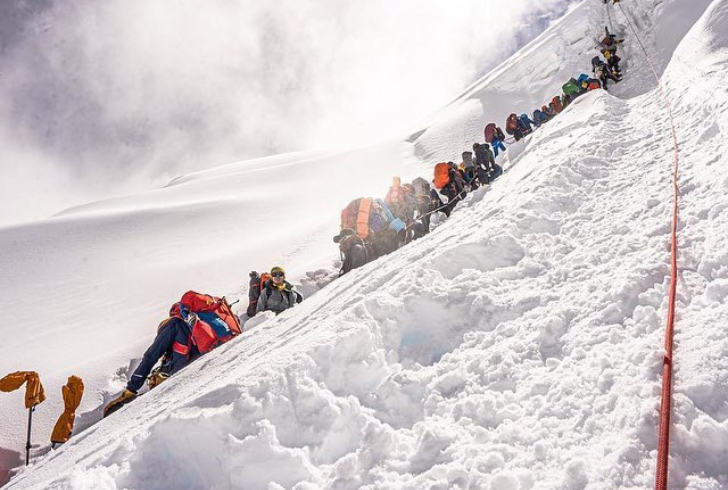How Long Does It Take to Hike Mount Everest?
Everest, the Earth’s crown jewel, has captivated hearts and beckoned adventurers for decades. But scaling this behemoth is no walk in the park. It’s a grueling test of physical and mental strength, demanding meticulous planning, unwavering determination, and a healthy dose of patience. So, how long does it take to hike Mount Everest?
Buckle up, thrill-seekers, because the answer goes far beyond a single number. It’s a multi-faceted odyssey that stretches over months, demanding commitment on multiple fronts.
Building the Foundation for Success (1 Year or More)

Instagram | mounteverestofficial | Reaching Everest’s summit isn’t spontaneous; it’s the result of a year-long or even longer journey.
The summit of Everest isn’t a destination you reach on a whim. It’s the culmination of a year-long or even longer odyssey. Imagine it as the intricate training montage in a movie – that’s what your pre-climb preparations will feel like. This phase is all about meticulously crafting the foundation for your success.
-
Building an Indestructible Body: Get ready to push your physical limits. We’re talking intense gym sessions, grueling hikes, and simulated high-altitude training. The goal? To transform your body into a machine capable of withstanding the extreme conditions Everest throws your way.
-
The Nitty-Gritty of Logistics: Permits, guides, gear – climbing Everest is like planning a complex military operation. You’ll be researching, scouting, and acquiring everything you need to survive on the mountain. Think specialist clothing, top-notch equipment, and enough supplies to last for weeks. Remember, on Everest, preparation is paramount.
-
Respecting the Mountain’s Might: This isn’t just about ticking a box on your adventure bucket list. It’s about understanding the mountain’s power and respecting its dangers. Researching weather patterns, avalanche risks, and potential health issues at high altitudes is crucial.
Adapting to the Thin Air (4-8 Weeks)
Reaching Everest Base Camp is just the first step. Here, a new challenge awaits – acclimatization. The air gets thinner as you climb, and your body needs time to adjust to this oxygen-deprived environment. Imagine it like a deep-sea diver slowly ascending – that’s the approach here.
Several weeks will be spent making short climbs to higher altitudes and then returning to Base Camp. It’s a slow waltz with the mountain, a crucial step to avoid altitude sickness and ensure your safety.
The Climb Itself (40 Hours Spread Over Several Days)

Instagram | himalayanhigh | Climbing Everest is a slow, steady march that takes around 40 hours spread over several days
Climbing Everest is a meticulously paced affair, a slow and steady march towards the summit. The journey typically takes around 40 hours, but these hours are spread over several days. Climbers ascend via the South Col Route, making calculated steps, incorporating rest breaks, and strategically factoring in sleep.
It’s a marathon at the edge of the world, demanding a sustainable pace and a focus on energy conservation. The key here is calculated progress, not reckless speed.
Patience is Key (Days or Even Weeks)
Everest’s weather is notoriously fickle. It can transform from a serene giant to a raging blizzard in a heartbeat. Therefore, a significant portion of your expedition might involve waiting at Base Camp, keeping a watchful eye on the skies. This waiting game can be frustrating, sometimes stretching for days or even weeks.
But remember, patience is paramount. You don’t conquer Everest – you wait for Everest to grant you permission to climb. The summit push can only happen when the weather offers a clear window of opportunity.
The Descent and Recovery

Instagram | mounteverestofficial | Descending is vital, requiring caution. Afterward, days at Base Camp for recovery, then a week-long trek to Lukla.
Reaching the summit is a monumental feat, but it’s only half the story. The descent is just as crucial, demanding focus and caution. Several days will be spent recuperating at Base Camp before you embark on the week-long trek back to Lukla. This return journey is no cakewalk, but after conquering Everest, you’ll approach it with a newfound confidence.
Finally, Kathmandu beckons, offering a few days for further rest and recovery before you head home. Climbing Everest is a holistic experience – the climb itself is just one chapter in this epic odyssey.
The Total Everest Journey
So, how long does it take to hike Mount Everest? The answer is a resounding – it depends. Factoring in all the stages – the year-long pre-climb prep, the weeks of acclimatization, the climb itself, the weather delays, and the post-climb recovery – the entire Everest expedition can range from two to three months. It’s a multi-faceted adventure that demands a significant time commitment.